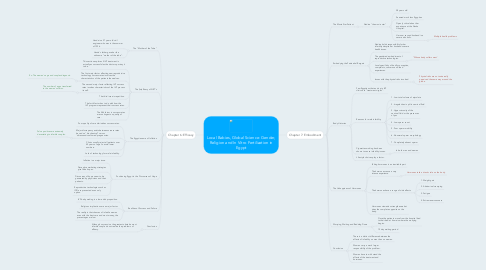
1. Chapter 6: Efficacy
1.1. The "Mother of the Tube"
1.1.1. Hunda is a 27 year old civil engineer who was in the summer of 1996.
1.1.2. Hunda's father gave her the nickname "mother of the tube".
1.2. The (In)efficacy of NRT's
1.2.1. This section explores if IVF treatment is actually as successful as the doctors portray it to be.
1.2.2. The first major factor affecting new reproductive technology success rates involves the characteristics of the patients themselves.
1.2.2.1. Ex: The women's age and couples diagnosis.
1.2.3. The second major factor affecting IVF success rates involves characteristics of the IVF process its self.
1.2.3.1. The number of eggs transferred to the woman's uterus.
1.2.4. The third issue is repetition.
1.2.5. The forth factor has to do with how the IVF programs represent their success rates.
1.2.6. The fifth factor is success rates are contingent on quality of care.
1.3. The Egyptian ame of Inflation
1.3.1. Poor quality of care diminishes success rates.
1.3.2. Major discrepancy exists between success rates based on "biochemical" versus 'ultrasound-confirmed' pregnancies.
1.3.2.1. False positives are extremely devastating to infertile couples.
1.3.3. Clinics usually reject all patients over 40 years of age to avoid lower numbers.
1.3.4. Lack of technology for male infertility.
1.4. Positioning Egypt in the Discourses of Hope
1.4.1. Inflation is a major issue.
1.4.2. Deceptive marketing strategies give false hopes.
1.4.3. Discourses of hope seem to be generated by physicians and their patients.
1.4.4. Reproductive technologies such as ICSI are presented as an only option.
1.5. Realities of Success and Failure
1.5.1. IVF baby making is a low-odds proposition.
1.5.2. Religious implications are a major factor.
1.5.3. The reality is that chances of infertile woman even with the best care and most money, the precentages are low.
1.6. Conclusion
1.6.1. Although success is a the greatest obstacle most infertile couple do not realize the problems of efficacy.
2. Chapter 7: Embodiment
2.1. The Movie Star Patient
2.1.1. Nadine "the movie star"
2.1.1.1. 38 years old
2.1.1.2. Seemed much less Egyptian
2.1.1.3. Openly critical about her experience at the Nozha Hospital.
2.1.1.4. Her now second husband is a severe alcoholic.
2.1.1.4.1. Multiple health problems
2.2. Embodying the Patriarchal Bargain
2.2.1. Nadine holds responsibility for her infertility despite her husbands severe health issues.
2.2.2. The gendered embodiment of reproductive technologies.
2.2.2.1. "Whose body suffers most'
2.2.3. Local specificity of bodily conception, complaints, concerns and lived experiences.
2.2.4. Issues with the physical risks involved.
2.2.4.1. Physical risks are not universally perceived the same way around the globe.
2.3. Body Histories
2.3.1. Few Egyptians that end up in IVF clinics are "treatment virgins".
2.3.2. Reasons for male infertility:
2.3.2.1. 1. Low total volume of ejaculate
2.3.2.2. 2. Irregularities in pH in seminal fluid
2.3.2.3. 3. Hyper-viscosity of the seminal fluid or the presences of pus
2.3.2.4. 4. Low sperm count
2.3.2.5. 5. Poor sperm mobility
2.3.2.6. 6. Abnormal sperm morphology
2.3.2.7. 7. Completely absent sperm
2.3.3. Cigarette smoking has been shown to cause infertility issues.
2.3.3.1. In both men and women
2.3.4. Life style choices play a factor.
2.4. The Unhappiness of Hormones
2.4.1. Taking hormones is an inevitable part
2.4.2. The hormones cause a very intense experience.
2.4.2.1. Hormones take a drastic tole on the body.
2.4.3. The hormones have a range of side effects
2.4.3.1. 1. Weight gain
2.4.3.2. 2. Abdominal cramping
2.4.3.3. 3. Fatigue
2.4.3.4. 4. Extreme nervousness
2.4.4. Hormones viewed as strengtheners but does the complete opposite on the body.
2.5. Worrying, Waiting and Bedding Down
2.5.1. Once the patients move from the hospital bed to their bed at home is where the worrying begins.
2.5.2. 15 day waiting period
2.6. Conclusion
2.6.1. There is a distinct difference between the effects of infertility on men then on women.
2.6.2. Women carry a much larger responsibility of the problem.
2.6.3. Women have to with stand the effects of the treatment and hormones.
